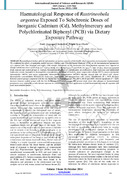Haematological Response of Rastrineobola argentea Exposed To Subchronic Doses of Inorganic Cadmium (Cd), Methylmercury and Polychlorinated Biphenyl (PCB) via Dietary Exposure Pathway
Abstract
Haematological indices provide information on various aspects of fish health when exposed to environmental contaminants. We evaluated the effects of cadmium, methyl mercury (MeHg), and Polychlorinated Biphenyl (PCB) on the haematological parameters
of a tropical fish. One hundred and eighty (180) mature individuals of the freshwater fish Rastrienobola argentea were exposed to dietary subchronic doses of Cd (4 µg g g1 CaCl2), MeHg (0.1 CH3HgCl µg g1 ) and PCBs (0.2 µg g1). After 45 days, blood was sampled from exposed and control groups to evaluate haematological effects of contaminants on erythrocytes, total leukocytes and differential leukocytes counts, haematocrit, heemoglobin concentration, red blood cell indices, mean corpuscular volume (MCV), mean corpuscular haemoglobin (MCH), and mean corpuscular haemoglobin concentration (MCHC). Results showed that red blood cells counts,
haemoglobin concentration, haematocrit, leukocytes, neutrophils, and mononuclear cells counts, significantly (P < 0.05) decrease between control groups compared with the Cd, MeHg and PCB tested groups. The MCV, MCH and MHC showed significant (P > 0.05)
increase between control groups with the Cd, MeHg and PCB tested groups. The present study shows that changes in haematological parameters were detectable at sub-chronic exposure to contaminants, but their application in field biomonitoring using R. argentea will need more detailed studies.
